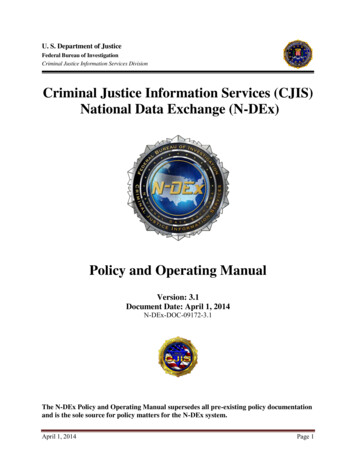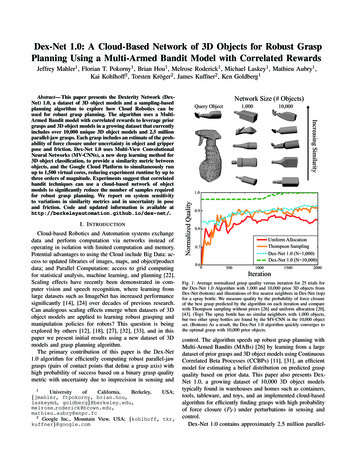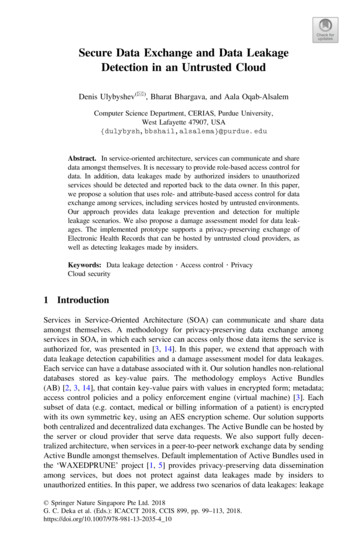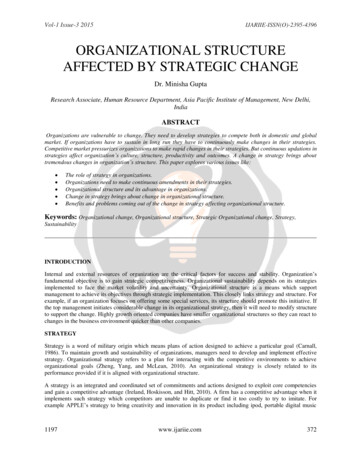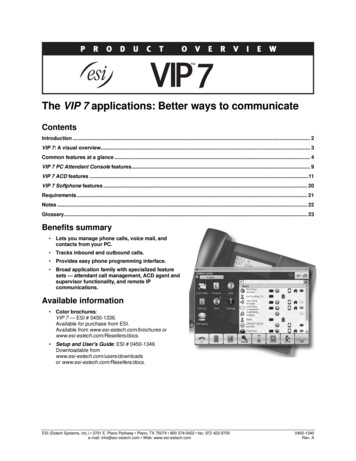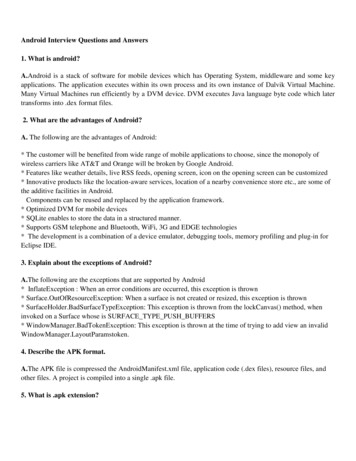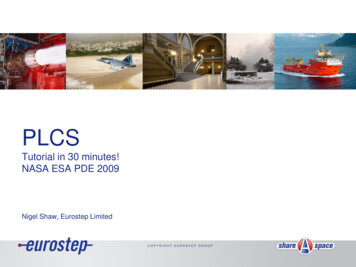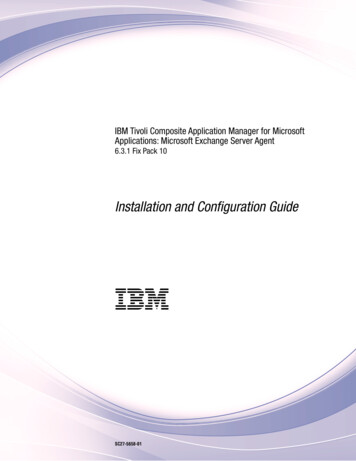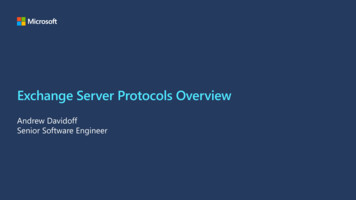
Transcription
DO.EXCHANGEVERSION 1.0.0WHITEPAPERA Decentralized Exchange (DEX)That is driven by the Automated Market Maker (AMM)protocol, with the aim to provide liquidity to CardanoBlockchain projects that issue native tokens.
TABLE OF CONTENTSAbstract. 3Introduction. 4Why DOEX is on Cardano blockchain?. 6Cardano vs Ethereum. 7ADA-ERC20 token bridge. 9Automated Market Maker (AMM). 10Decentralized Exchange. 12How Cardano Projects are Overcoming the ConcurrencyIssue. 12Market analysis (DeFi). 14Tokenomics. 15Features. 16Utility of the Token. 17Roadmap. 18Disclaimer. 192
ABSTRACTDecentralized Exchanges or DEX perform the same function as their centralized counterparts.However, with DEX, users only interact with self-enforcing smart contracts to carry out secure andnon-custodial transactions without the need of centralized third parties.This document introduces and describes DOEX – a Cardano Blockchain-based decentralizedexchange that uses Automatic Market Making protocols to execute transactions. DOEX strikingfeatures include multiple pricing functions for a single liquidity pool, trade routing, instant pricefeed via on-chain price oracle, and automatic babel fees redemption for Stake Pool Operations(SPOs) that are Cardano Blockchain-based.3
INTRODUCTIONAlthough one of the top performing blockchain networks, Cardano is yet to have a nativeDecentralized Exchange like those seen in other blockchain networks. This means that there isno exchange list for tokens of projects that are based on Cardano Blockchain. Interestingly, thiswill soon become a thing of the past as DOEX is set to be the first Cardano Blockchain-basedDEX with which liquidity will be provided to native assets on its network. The Cardano Blockchainupdate referred to as Mary Hard Fork that was completed on the 1st of March allows anyone tocreate native cryptocurrency assets on the blockchain. As such, it allows Cardano to have multiasset support and users can create custom tokens as well as execute transactions directly on theCardano blockchain.With Mary Hard Fork, Cardano blockchain now offers several tokenization options and supportsthe blockchain to provide transactions that involve several asset types at the same time. Nativesupport of tokens is an important leverage for developers as it saves them the stress of using smartcontracts to create custom assets or transactions. With this, the transfer of asset ownership istracked by the accounting ledger thus removing the complexity, errors and security vulnerabilitiesfrom the equation in a cost-efficient manner. More precisely, native tokens on the CardanoBlockchain do not require the extra efforts that come with the creation of smart contracts totransfer their value and users can carry out transactions and burn their tokens without incurringsmart contract transaction fees or adding event-handling logic to track transactions.This update enables the creation of fungible and non-fungible tokens, which in turn enablesusers to create custom payment asset, stable coins pegged to fiat currencies, assets to representintellectual property (IP), etc. These assets can then be used to seamlessly carry out transactions.There are three ways by which assets can be created on the Cardano Blockchain. They include: Cardano Command Line interface (CLI); Token Builder graphical user interface (GUI); Daedalus wallet.The lifecycle of the native assets is made up of 5 phases: Minting; Issuance; Using; Redeeming; Burning.4
The use of Cardano Command Line Interface (CLI) involves the technical know-how of settingup and operating the Cardano node as well as having the knowledge of handling transactions andmanaging wallet addresses and technical values. The GUI token builder on its own makes tokencreation and deployment seamless and facilitates token creation for Decentralized Applications(DApps) other specialized forms of tokens like NFTs, and fiat-pegged stablecoins. Daedalus andYoroi wallets allow users to make use of existing assets for payments and purchases or exchanges.DApps can be created on Cardano by taking advantage of the features brought by Goguen eradevelopments like Mary hard fork, Plutus and Marlowe - all of which are significant developmentsin the capabilities of Cardano. More specifically, Plutus is a smart contract language and executionplatform that consists of On-chain (on Cardano Blockchain) and Off-chain (on the user’s machine)branches and uses the Haskell programming language. It allows the use of Alonzo update - asdepicted in the final phase of Goguen on the roadmap of Cardano. Goguen will also deliver othercore offering improvements, most importantly - multi-asset ledgers.The Alonzo update or hardfork brings about new and promising features to the Cardano Blockchainas it will enable smart contracts on the network via the integration of Plutus scripts. Alonzo adds alot of opportunities for businesses and developers by facilitating the development of DecentralizedFinance (DeFi) focused DApps and smart contracts. Alonzo brings a systematic approach that isbased on verification and formal methods to extend the simple multi-signature scripting languageused in Cardano Shelley. Being an updated and extended effort on the Plutus smart contractlanguage, Multisig ensures more efficient and stable scripting options.Powerful scripting is facilitated by Alonzo via the use of an extended model of unspent transactionoutput (eUTXO). This is made possible by using the hard fork combiner technology of IOHK the parent infrastructure research and engineering company overseeing Cardano. This leadsto efficient smart contracts that facilitate seamless and efficient automated assets tradingapplications and large cash movements. Apart from this, developers are equipped with tools toexperiment, validate, and customize Cardano transactions. The APIs library will be expanded sothat it can allow the deployment and operations of Plutus Core code while communicating withwallets and the distributed ledger.Daedalus update is the precursor of the Alonzo update, and it allows users to use their wallet toreceive both ADA and several other assets on the Cardano network. The advent of Daedelus bringsabout the switch from platform’s stake pools to community-led stake pool operators.5
WHY DOEX IS ON CARDANOBLOCKCHAIN?Like other blockchains, Cardano has several advantages. It is scalable, fast, has low transactionfees that can be paid with the same token sent. Although blockchains like Ethereum have a higherdegree of acceptance than Cardano, we trust in the Cardano Blockchain potential to attract developers and new venture capitalists which will catapult its adoption in the near future.In addition, Cardano has a layered blockchain architecture that is composed of two main elements,the Cardano Settlement Layer (CSL) and Cardano Computational Layer (CCL), which makes ittruly unique.Most of the other existing blockchain platforms only have a single layer, which leads to scalabilityissues and often causes network congestion, slows down transactions and leads to higher networkfees. Ethereum processes approximately 15 transactions per second (TPS). This small amount ofTPS makes the network slow and congested within a short time. Cardano on the other hand doesnot have these scalability issues. Simulations have shown that each “Hydra head” of the Cardanonetwork can currently process about 1,000 transactions per second. This can be combined with1,000 stacking pools, each of which processes 1,000 TPS. As such Cardano could achieve up to 1million transactions per second which makes it super-fast at executing transactions at a very lownetwork fee.Cardano and Ethereum networks have very similar properties. This includes ease of creation ofsmart contracts and building decentralized applications (DApps). However, the philosophical notions of their creation and their design viewpoints are quite different.6
CARDANO VS ETHEREUMFOUNDEDSeptember 27th, 2017December, 2013CREATORSTechnologists Charles Hoskinson andJeremy Wood.Vitalik Buterin, Anthony Di, CharlesHoskinson, Mihai Alisie & Amir Chetrit.TICKERADAETHVISIONThe primary function of Cardano is tofacilitate operations in its native token- ADA and to empower the developercommunity to build secure decentralized applications with amazing usecases.The aim of Ethereum aimed is to become a global, open-source platformfor the creation of custom assets andvarious DApps.Cardano emphasizes an approach thatis purely based on research with theaim to facilitate mainstream adoptionof the technology.Cardano uses mathematically verifiedcodes to provide users and developercommunity with excellent optimizationsthat are grounded in scientific research.LAUNCH &ISSUANCEThe Cardano Network is managed andsupervised by three institutions. Theyinclude:1. Cardano Foundation: responsible forthe management of all aspects of thenetwork’s blockchain.2. IOHK: created and designed theblockchain and its proof-of-stake algorithm.Ethereum uses the offers several otherdecentralized products and use casesapart from financeEthereum was adopted by variousblockchain projects during the ICO rushto raise funds for their project.The currently most popular use ofEthereum is the creation of Decentralized Finance applications. Which isaimed at decentralizing core traditionalfinancial use cases like lending/borrowing and removing centralized thirdparties and middlemen such as banksor mainstream financial institutionsfrom transactions.The objective of Ethereum is to be aglobal launchpad blockchain projectwhere everyone can launch and run anapplication.To pursue this objective, Ethereumsold 72 million Ether (ETH). It’s nativecurrency.Ethereum network has a brilliant community of developers, who actively7
3. Emurgo promotes the adoption andindustry-wide acceptance of the network’s technology for various institutions.Worthy to mention is that about 31billion ADA tokens were created.NETWORKDESIGNTo make the network secure, Cardanouses a Proof-of-Stake-like consensusmechanism named Ouroboros. Withit, users earn newly minted ADA whenthey validate transactions.Time is divided into epochs and slotsby Ouroboros and the epochs are widetime frames while slots are 20-secondincrements within the epochs.For each slot, a leader is selected andhe is responsible for selecting theblocks that are added to the blockchain.At the end of an epoch, the previouslyselected slot leaders will choose theleader of the next epoch among themselves.MONETARYPOLICYengage in network expansion, growthand the creation of other networks andinnovative projects.Some of them include: Gavin Wood,Jeff Wilke, Joseph Lubin, and CharlesHoskinson. They have industry experience and are now leaders in the blockchain community.Smart contracts are written by developers for the creation of DApps. Thesesmart contracts are then deployed tothe Ethereum Blockchain. The Dappscan be activated once a specific goal orresult is achieved.Ethereum uses the Proof-of-work consensus mechanism to run its blockchainjust like Bitcoin Blockchain. However, it will soon move to Ethereum 2.0that runs a Proof-of-Stake consensusmechanism.With Ethereum 2.0, any user with atleast 32 ETH will be able to lock up thefunds in a contract and be incentivizedfor solving computations that help toadd new blocks to the blockchain.ADA is the native currency that drivesCardano and it is minted on everyblock. It is also the means by which slotleaders are rewarded for transactionverifications.Like ADA, Ether (ETH) is the nativecurrency that drives the Ethereumnetwork. It is minted in every block andgiven out as reward to miners for theircomputing power.ADA has a limited supply. This meansthat its total supply is capped at 45billion.There is a sharp contrast between ETHand ADA here because ETH does nothave a limited supply. Rather, its supplyis programmed to increase by 4.5%annually.As at January 2021, 31 billion ADA werein circulation and the 14 billion tokensthat are left will be issued via minting.Changes to the monetary policies ofEthereum have been suggested bydevelopers and it was voted upon bynodes and miners.Gas or network fee is another corefeature that drives the Ethereumblockchain. It is a unique computationalunit that is applied for the computationfees.8
ADA-ERC20 TOKEN BRIDGEAs earlier mentioned, the Cardano network supports ADA - its native token and the tokens of othersuccessful projects created on its network with over 160,000 tokens minted. To ensure betterinteroperability across chains so that a solid background can be laid for extended business andexpansion opportunities, an ERC20 converter is a sure deal.The converter allows issuing organizations, projects and their users to handle the migration ofERC20 tokens to Cardano, i.e. it enables them to move their ERC20 based tokens to the Cardanonetwork with just a few clicks. The converted token will have the same value and will work the sameway as the ERC20 it is converted from in addition to this, users that wish to do this later can alsomove their tokens back to the source network by burning them on Cardano. The ERC20 converterhas a 2-way convertibility baked in.It is worthy to mention that it is possible to use Metamask (a Chrome browser extension) to validatean account with more options to be added later. For users to be able to easily migrate their tokens toCardano and track transactions and balances, they must add their Daedalus testnet address.When a user accesses his ERC20 converter account, he will see SingularityNET tokens listed andavailable for migration once he clicks a token. All that is required of the user to carry out a conversion is to select the token, type the amount he would like to convert and add a Cardano address tomigrate the token. Once the token migration to the Daedalus wallet address is carried out, it canthen be used for any payment or transaction that the user desires while the activities will be visiblewithin both - Etherscan and the Cardano Explorer.9
The ERC20 converter will be made available for the public after the quality assurance testing iscomplete. At the moment, it is being tested to ensure a top-notch user experience as well as fix anyissues or vulnerabilities that may exist. Relevant documentation and instructions on how the userscan test the converter capabilities will soon be provided to the dedicated testnet environment.AUTOMATED MARKET MAKER (AMM)AMM or Automated Market Maker exchange models are changing the narrative in both traditionaland decentralized finance. It is the underlying protocol that drives decentralized exchanges (DEXs)and it is designed to exchange one token for another directly, bypassing trading platforms andother intermediaries.Before AMM came into prominence, exchanges used to use a classical order book mechanismto match trading orders. As such, they only serve as intermediaries - matching buyers to sellersand taking a cut of the transaction. Unfortunately, they suffered from liquidity issues, caused bya number of factors, including as time required to place each order, block confirmation times andslippage issues. As a result of this, the price of an asset at the point of executing a trade can shiftconsiderably before the trade is completed. This often occurs in volatile environments like thecrypto market. Hence, the exchanges must ensure that transactions are executed instantaneouslyto reduce price slippages.How Does an AMM Work?Automated market markers replace the conventional matching system and order books with autonomous protocols that are powered by blockchain-based smart contracts. These smart contractsdefine the price of a cryptocurrency asset and are also responsible for liquidity provision. As such,traders trade against the liquidity locked in the smart contract and not the counterparties like theirtraditional finance counterparts. Also, to carry out exchange operations using AMMs, the userdoesn’t need to create an account on the exchange, go through any KYC procedures or entrusttheir funds to third parties. All the user needs to do is connect the browser wallet, select the exchange direction, and make the transaction.What happens next is that the smart contract will automatically send the corresponding amountof cryptocurrency assets to the user’s wallet. DOEX uses this exact same method to execute thetrades. The platform solves performance restrictions of AMMs that come before it by leveragingthe interoperable, fast, and secure, liquidity provision features of smart contracts created on theCardano network. A couple of points to note:10
Trading pairs exist as individual liquidity pools (LP) in the AMMs; Instead of using dedicated market makers, anyone can provide liquidity to these pools bydepositing both assets represented in the pool.To ensure the ratio of assets in the liquidity pool is balanced, AMMs use mathematical equationsand existing protocols use an equation as simple as X x Y K where X and Y represent the valueassets A and B respectively and K is a constant.Essentially, the liquidity pools on AMMs alwaysmaintain a state whereby the multiplication ofequals the same number.How AMM Liquidity Providers EarnLiquiditythe price of Asset A and the price of B alwaysAs earlier mentioned, AMMs use liquidity toexecute trades. Whenever liquidity is depositedinto a pool, special tokens known as liquiditytokens are minted to the provider’s address inproportion to how much liquidity they contributed to the pool. These tokens are a representation of a liquidity provider’s contribution to apool. Whenever a trade occurs, the fee which isPriceCFMMs provide liquidity across theentire price range.levied is distributed pro-rata to all liquidity providers in the pool at the moment of the trade.To put it simply, when a user supplies an asset – provides liquidity to the pool, it automaticallybecomes a fungible resource. The token deposited in the liquidity pool is denoted with a value ofa derivative. This gives the supplier the ownership rights of the reward paid on the total amountsupplied. The assigned derivative is, thus, defined as an increasing percentage ownership claim ofa portion of the liquidity pool supplied to the smart contract. With that, liquidity providers can thenchoose to sell, transfer, or otherwise use their liquidity tokens in any way they see fit. To summarize, when you make a deposit of your token into Liquidity Pools, you will receive an LP token and ashare of the transaction fee.11
DECENTRALIZED EXCHANGEA Decentralized Exchange or DEX (DEX) is a blockchain-based application that is accessiblethrough a series of smart contracts and is designed to facilitate financial services that are traditionally carried out by a central entity in a decentralized manner.With DEX, trustless parties can carry out financial transactions by relying only on the self-enforcingability of smart contracts. Apart from decentralizing access to financial services, it also ensures thatprofit from the financial services are decentralized.Participants that provide liquidity to facilitate exchange, swap and other types of operations ondecentralized exchanges are rewarded with a small fee and it serves as a means of passive incomegeneration for individuals. Something that is only reserved for large institutions in the traditionalfinance.There are a lot of existing DEXs on different blockchains. Examples include PancakeSwap on Binance Smart Chain (BSC) as well as UniSwap and Curve on Ethereum Blockchain. DOEX on its ownis being built for Cardano Blockchain to facilitate the swap of Cardano Blockchain-based assets.HOW CARDANO PROJECTS AREOVERCOMING THE CONCURRENCY ISSUEUnderstanding ConcurrencyIn general, concurrency is the ability of multiple agents to interact with the same smart contract atthe same time with the intention to achieve the same result. In decentralized finance or DeFi parlance, it is the ability of a DEX to allow multiple executions of swap or exchange operations at thesame time without issues. In fact, after Cardano announced the launch of the Plutus smart contract functionality on testnet, some DEXs have launched on the testnet and ran into severe concurrency issues with their DApp. Thus, being able to handle only one transaction per block, raisingconcerns about Cardano’s capability to run smart contracts.Cause of the IssueIt has been observed that the concurrency issue is due to how the Cardano blockchain is usingunspent transaction outputs or UTXO-accounting models rather than an accounts-based model,12
used by the likes of Ethereum. As such, designing a DEX that overcomes concurrency has beentricky. Ethereum, Solana, and most other smart contract enabled-blockchains employ an account-based model to compute transactions while Cardano employs a novel iteration of Bitcoin’sUTXO model called Extended UTXO (EUTXO).The EUTXO model poses challenges for Cardano dApp builders. Account-based models allowmultiple users to interact with the same smart contracts by default. However, EUTXO-based smartcontract blockchains pose difficulties for developers to mitigate concurrency without makingcompromises on security or decentralization. From a technical point of view, the Cardano teamexplained in a long-form blog post that transaction validation is divided into two phases and thereason is that it should limit the amount of uncompensated validation work by nodes.Each phase serves a purpose in achieving this goal. The first phase checks whether the transactionis constructed correctly and is able to pay its processing fee. The second phase runs the scriptsincluded in the transaction. If the transaction is phase-1 valid, phase-2 scripts run. If phase-1 fails,no scripts run, and the transaction is immediately discarded.How Projects are Overcoming the Concurrency ChallengeInterestingly, some projects have come up with working solutions for the Cardano concurrencyissue. Some of these include building DApps that tolerate segmentations of state or aggregatingmultiple interactions to settle on the same state. For decentralized exchanges, this would meaneither fragmenting liquidity into multiple pools (states) or using third-party sequencers to batchmultiple transactions and settle them as one transaction in the same state.Other proposed solutions for scaling DApps on Cardano involve implementing Layer 2 protocolsand sidechains, which deal with their own unique centralization and security challenges (while suchsolutions are yet to go live on Cardano, at least one EVM-compatible sidechain is in the pipeline).Also, Cardano partners are already developing solutions that can lay an account-based model atopa UTXO-type chain for developers who prefer that way of working.13
MARKET ANALYSIS (DEFI)The DeFi niche of the decentralized finance industry is a huge niche that is set to bring core traditional finance use cases like exchange, swap, staking, lending/borrowing, currency issuance,peer-to-peer payment and even insurance on the blockchain. As a result, centralized third partiesand intermediaries are eliminated from transaction activities and all of which are carried out on theblockchain.According to DeFiPulse, the total value locked (TVL) in DeFi protocols followed an exponentialtrend and rose to 87 billion in May 2021. The biggest share of the DeFi market is taken by Decentralized Exchange projects as well as infrastructure service providers such as liquidity pools orstaking providers that help users to execute validation nodes for Decentralized protocols.Decentralized exchanges executed transactions worth over 60 billion, which is an upward trendthat overshadowed the 26 billion that was recorded in September 2020. Pancakeswap andUniswap dominated the market in this niche and it confirms that there are still a lot of untapped opportunities in the industry especially for a project like DOEX that will be launched on a formidableblockchain network like Cardano.Source: Defipulse14
TOKENOMICSDOEX will issue 140 000 000 DOEX, native tokens on Cardano blockchain.Private Sale 22%Public Sale Round 1 17%Public Sale Round 2 12%30,800,000 tokens23,800,000 tokens16,800,000 tokensPrice 0.05 USD4 months lockupPrice 0.11 USD100% unlocked upon listingPrice 0.15 USD100% unlocked upon listingDistributionof TokensTotal supply140,000,000 DOEXStaking 15%21,000,000 tokensMarketing 5%Team 14%Token Liquidity 15%7,000,000 tokens19,600,000 tokens21,000,000 tokens3 months lockup. 20% of theamount released every monthonce the lockup is over.6 months lockup. 10% of theamount released every monthonce the lockup is over.Used for exchange liquidity15
FEATURESSupports any Cardano native assetParticipate in liquidity pools to earn fees on ADA - Cardano Native Assets pairsAutomated pricing that is liquidity sensitive using AMM protocolTrade ADA for any Native Token on the Cardano BlockchainTrade any Cardano Native Token for another in a single transactionTrade and transfer to a different wallet address in a single transactionPurchase ADA or any other Cardano Native Token from Yoroi wallet16
UTILITY OF THE TOKENDOEX token is the native token of the DOEX platform and it is a utility token with several use casesthat will drive adoption and increase its demand. Our aim is to make DOEX a truly decentralized,community driven protocol. For this purpose we have issued DOEX token with a voting function.Holders of the token will have voting rights and power based on the amount of tokens they haveand will be able to debate, propose, and vote on all changes proposed to the DOEX platform. Thisallows the protocol to be upgraded by anybody with a good idea and they are incentivized accordingly.According to available protocols, the common method that users employ to delegate their votingrights on proposals is by raising the relevant functions directly. For a proposal or function to gothrough and be accepted by the community, majority of the votes cast must be in favour. In a situation where there are more than two options, the proposal that has the highest votes wins. Platformusers or community members will need to hold DOEX tokens to vote and it will be locked until thevoting period ends.A summary of the uses of DOEX token include: Ability to cast votes and participate in the governance of the platform Incentivization of platform members Payment of fees such as Swap fees and slippage fees Participation in Liquidity Pool Payment of reward to Liquidity Providers17
ROADMAP2021 Q2Idea generationand refinementMarket and competitorresearchRecruitment ofthe team2021 Q3Design ofthe websiteCreation ofthe DOEXWhitepaperCreation ofwireframes for eachfeature and page.Design of the UIof the completeprojectMarketingCampaignPrivate SalePublic IEOAlonzo Main-net(Cardano SmartContract)2021 Q42022 Q1DEX/AMMdevelopment and launchOfficial DOEXplatform launch DEXDOEX Wallet UI/UXdevelopmentWallet for Cardano’snetwork currencies.Bank partner onboardingand due dilligenceCrypto-Fiat exchangeon DOEX DEXMobile APP developmentWhite-Label Solution2022 Q22022 Q32022 Q418
DISCLAIMERThis paper is intended to convey general information only. It should not be taken as an investmentadvice or a solicitation or recommendation to take part in any investment and should not be usedas a yardstick to evaluate the pros of making any investment decision. It should also not be takento make accounting, legal or tax decisions or investment recommendations. This document showscurrent opinions of its authors and is not made on behalf of DOEX or their affiliates and staff. Assuch, it does not necessarily reflect what DOEX, their affiliates or individuals associated with themopines. The thoughts reflected herein are subject to change without prior notice.19
come a global, open-source platform for the creation of custom assets and various DApps. Ethereum uses the offers several other decentralized products and use cases apart from finance Ethereum was adopted by various blockchain projects during the ICO rush to raise funds for their project. The currently most popular use of
